Francisco del Rosario Sánchez
Francisco del Rosario Sánchez (9 March 1817 – 4 July 1861) was a Dominican revolutionary, politician, and former president of the Dominican Republic. He is considered by Dominicans as the second leader of the 1844 Dominican War of Independence, after Juan Pablo Duarte and before Matías Ramón Mella. Widely acknowledged as one of the founding fathers of the Dominican Republic, and the only martyr of the three, he is honored as a national hero. In addition, the Order of Merit of Duarte, Sánchez and Mella is named partially in his honor.
Francisco del Rosario Sánchez | |
|---|---|
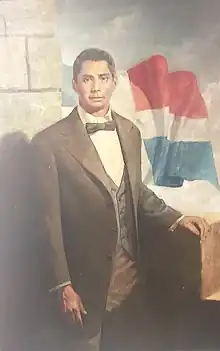 Portrait of General Francisco del Rosario Sánchez c. 1840s-1850s | |
| In office 28 February 1844 – 1 March 1844 | |
| Vice President | Manuel Jimenes (interim) |
| Preceded by | None |
| Succeeded by | Tomás Bobadilla |
| Governor of Santo Domingo | |
| In office 1856-1858 | |
| Appointed by | Buenaventura Báez |
| In office 9 June 1844 – 16 July 1844 | |
| Vice President | None |
| Preceded by | Tomás Bobadilla |
| Succeeded by | Pedro Santana |
| Personal details | |
| Born | 9 March 1817 Santo Domingo, Captaincy General of Santo Domingo (now Santo Domingo, Dominican Republic) |
| Died | 4 July 1861 (aged 44) San Juan de la Maguana, Dominican Republic |
| Cause of death | Execution by firing squad |
| Resting place | Altar de la Patria |
| Nationality | Dominican |
| Political party | Central Government Junta |
| Other political affiliations | La Trinitaria |
| Spouse |
Balbina de Peña Pérez
(m. 1849) |
| Domestic partner(s) | Felícita Martínez, María Evarista Hinojosa, Leoncia Leydes, Mercedes Pembrén |
| Relations | Socorro Sánchez del Rosario (sister) María Trinidad Sánchez (paternal aunt) |
| Children | Mónica, María Gregoria, Leoncia, Petronila, Juan Francisco, Manuel de Jesús |
| Parents |
|
| Occupation | Lawyer, politician, teacher, independence leader |
| Known for | Hoister of the tricolor flag of February 27 Martyr of El Cercado |
| Awards | National hero |
| Military service | |
| Allegiance | |
| Branch/service |
|
| Years of service | 1838 – 1861 |
| Rank | General |
| Battles/wars | Dominican War of Independence Cibaeño Revolution |
| Honors | Order of Merit of Duarte, Sánchez and Mella |
| Though not the first constitutional president, Sánchez took office as the first president of the provisional government. The first constitutional president wouldn't be installed until 14 November 1844, with Pedro Santana taking office. | |
Following Duarte's exile, Sánchez took leadership of the independence movement, while continuing to correspond with Duarte through his relatives. Under Sánchez, the Dominicans would successfully overthrow Haitian rule and declare Dominican independence on 27 February 1844. With the success of the separation from Haiti, Sánchez took office as the Dominican Republic's first interim president before ceding his position.
But his ideas of an independent state were fiercely challenged by many within the sector who felt that the new nation's independence was only a temporary success. Because of his patriotic ideals, Sánchez, like many of his peers, would be on the receiving end of these political struggles. His main political rival was none other than the military general, Pedro Santana. His status as a patriot came with many unfortunate consequences, including incarceration, deprived of his assets, exiled throughout the Caribbean, and worst of all, the death of his companions.
By 1861, his worst fears of the end of the republic came to reality upon learning that the pro-annexation group led by Santana agreed to reintegrate Dominican Republic back to colonial status. With no time to waste, Sánchez rushed back to his homeland to challenge this decision, but was lured into a trap by the very same people who allied with him, leading to his unfortunate death on 4 July 1861. His death triggered a national outrage throughout the island, and marking a new era of struggle for independence, which was eventually achieved in 1865.
Background
Origins and family life
Sanchez was born on 9 March 1817, in the city of Santo Domingo, during the years of a 12-year era known to Dominicans as España Boba. This period was plagued into an economic and cultural crisis, in view of the fact that, when Juan Sánchez Ramírez managed to get the "Junta de Bandillo" at the end of 1808 to decide to return to Spain or reincorporate it after defeating French general Jean-Louis Ferrand, in the Battle of Palo Hincado, who applied the Treaty of Basel in 1804, through which Spain ceded this part of the Island to France in 1795. Spain was under the Napoleonic invasion, which prevented meeting the requirements of the reacquired colony.[1]
Sánchez was the son of Olaya del Rosario Belén (1791–1849), a free woman of color,[2][note 1], and Narciso Sánchez Ramona (1789–1869), a tall man who was a descendent of slaves.[3][4] Because of their different racial and social-economical status (hers being superior to his), Narciso Sánchez and Olaya del Rosario married after a special authorisation given by the mayor.
His mother was a hairdresser who produced combs, while his father worked in the meat trade, selling, butchering and raising cattle. Narciso inherited the occupation from his father, Fernando Raimundo Sánchez, of which mostly took place in the east, an area where livestock production was concentrated. This job placed him in an intermediate situation between the urban and rural world, which was very common at that time. Much of the herd owners preferred to live in the cities, so they appointment administrators. In the cases of Narciso Sánchez, despite being a resident of Santo Domingo, he spent much of his time in the mountainous life of ranching. According to historian Ramón Lugo Lovatón, his professions allowed him to achieve a certain level of social advancement. However, in his will, he clarified that the couple did not bring property to the marriage, indicating that his professions did not bring fortune to the family. [5]
His surnames are inverted because his parents were not married at the time of his birth, marrying in 1819.[4][6]
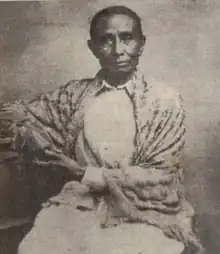
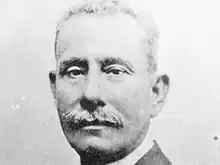
Sanchez had six children with several different women, the first being Felícita Martínez, with whom he procreated Mónica, born on 30 January 1838 when Sánchez was 20 years old. Some years later he procreated María Gregoria (Goyita), born on 30 November 1841, with María Evarista Hinojosa. Later, with Leoncia Leydes Rodríguez from Curaçao, he had Leoncia. Later with Mercedes Pembrén Chevalier he procreated Petronila.
On 4 April 1849, he married Balbina de Peña Pérez, with whom he procreated Juan Francisco and Manuel de Jesús. His son Juan Francisco was Minister of Finance in the government of Ulises Heureaux and was part of the government cabinet of also President Carlos Morales Languasco. Manuel de Jesús, on the other hand, died in infancy.
Education, early years and influences
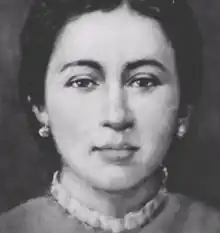
His childhood was spent in the framework of the period of Haitian domination of the eastern part of the island, which began in 1821 after the failure of the independence initiative of the enlightened José Núñez de Cáceres, which historians refer to as the "Ephemeral Independence." In spite of his humble origins, Sánchez grew up in a very nationalistic family. He first received his education from his mother, and later by the Peruvian priest Gaspar Hernández, a patriot who encouraged the young Sánchez to follow in his family's footsteps. He was also influenced by his father and aunt, Maria Trinidad Sánchez, both involved in the movement "Revolution of Los Alcarrizos," an early resistance that attempted to libertate Dominicans from Haitian rule under the dictatorship of Jean-Pierre Boyer, who invaded in 1822 and brought the whole island under his control. Unfortunately, this conspiracy was eventually discovered by Boyer, who order all those involved to be executed. Narciso, however, was imprisoned. This action not only caused Olaya to suffer, but it also accumulated into a long lasting fear and worry for her children and husband, who by now was marked as an enemy by the Haitians. And as the young Sánchez grew up emulating his father's revolutionary footsteps, her bitterness and concerns would transcend into the future.
In his youth, Sánchez used to accompany his father in the work of managing agricultural properties, which allowed him to interact with people of different social classes. Beyond what was instilled by his family, Sánchez maintained a effort to educate himself, which was key to his outstanding patriotic action. He was self-taught, like almost all of his classmates. He had a love for culture; he was fascinated with the Bible and even enjoyed reading material by Greek and Roman authors. Historian Juan Daniel Balcácer described Sánchez as tall, with dark skin, a thin build, and extremely circumspect. Possessing a fine sense of humor, he stood out among his friends for his constant smile, always on his lips. He played various musical instruments and enjoyed reciting poetry. While educated and having taught himself Latin, English, and French later in life, he is mostly remembered as a man of action.[7]
Rise to Leadership
Recruitment to La Trinitaria
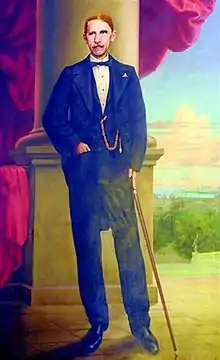
One day, while attending philosophy classes, he was approached by Juan Pablo Duarte, then 25 years old, who also attended these classes and was immediately intrigued by Sánchez's level of intellect. In 1838, Duarte founded the movement La Trinitaria, a nationalistic organization that intends to bring freedom to the Dominican people, who during this time were living in tyranny under Haitian rule. The main objective of this movement was to movement was to not only overthrow Haitian rule of Santo Domingo, but to establish an independent state free of foreign power. Seeing Sánchez as a perfect candidate for membership, Duarte didn't think twice before recruiting him. Sánchez had traveled to the U.S. and Europe as a young man. His vision of the cause was the typical republican goal of the Age of Enlightenment.
With his recruitment, it didn't take long for Sánchez to stand out for his industriousness and determination. Little by little, he gained a leading position in the organization, becoming a fundamental figure in the daily work to achieve the objectives that gave rise to it.[1] Eventually, not only would he prove to be a vital asset for the cause, but it would also allow him to earn Duarte's faith in him, placing his full trust on the young revolutionary.
However, the situation intensified when the new Haitian president, Charles Rivière-Herard, whom had previously allied with the Dominicans to overthrow Boyer, marched to Santo Domingo at the head of 10,000 troops to arrest the Trinitarios after discovering their plans. Learning of this action, Sanchez immediately leaves Los Llanos and heads straight for Santo Domingo, swimming across the Ozama River to notify Duarte of Herard's arrival. Unfortunately, many members of the movement, including Duarte, were arrested.
Substitute leader for Duarte
Juan Pablo Duarte's exile took place at the last and most crucial stage of the struggle. But it was when Duarte was exiled and in hiding in Venezuela that Sánchez became the central presence in the Dominican revolt. In 1843, when Duarte went into exile in Curaçao for fear of being assassinated or imprisoned by the Haitian authorities, Sánchez, then 25 years old, assumed the leadership of the independence movement La Trinitaria, where he presided over the group's meetings and expanded contacts with representatives of the most important social sector in the city, with the collaboration of fellow member Matías Ramón Mella, but in order to avoid being subdued by the Haitians, Sánchez spread a rumor that he had died of an illness.
Sanchez's revolutionary work was intense. He originally intended to consummate independence at the end of 1843 with only the Trinitarian forces. This made Sánchez, along with Vicente Celestino Duarte, request in letter assistance from Duarte:[8]
Juan Pablo:
With Mr. José Ramón Chaves Hernández we write to you on November 18, imposing on you the political state of this city and the needs we have for you to (get) help for the triumph of our cause. Now we take advantage of the opportunity of Mr. Buenaventura Freites to repeat to you what we tell you in the others in case they had not reached your hands.
After your departure, all the circumstances have been favorable, so that we only lacked a combination to have delivered the blow. To this date, the business is in the same state in which you left it: for what we ask you, even at the expense of a star from heaven, the following effects: two thousand or one thousand or five hundred rifles, at least: four thousand cartridges, two or three hundred weight of lead; five hundred spears or whatever you can get, the war utensils you can.
About money, you know more than anyone what may he needed; In conclusion what is essential is help, however small it may be, since this is the opinion of the majority of the headless. This achieved, you must go to the port if Guayacanes, always with the concern of being a little removed from land, about one or two miles, until you are notified, or signaled, for which purpose you will place a white pennant if it is daylight and a lantern above the mainmast if it were night.
Once all this has been determined, you will try, if possible, to communicate it to Santo Domingo so that you can go and wait on the coast on December 9, or before, because it is necessary to fear the audacity of a third party or an enemy of ours, the people being so inflamed.
Ramón Mella prepares to go there, although he tells us that he is going to Saint Thomas and it is not convenient for you to trust him, since he is the only one who has harmed us in any way again due to his blind ambition and imprudence.
The National Guard has been ordered to exercise here, and one afternoon, because a soldier had left the line, Mr. Colonel Alfau lashed him, but he miraculously escaped with a bayonet and had the sad disappointment of being almost attacked the entire first battalion and see nothing but his brother Abbot in his defense.
To Juan Isidro Pérez and Pedro Pina, who receive all the expression of affection that we could do if we saw them and that we did not write to them separately due to lack of time.
Juan Pablo, we repeat the greatest activity, let's see if we make the month of December memorable forever.
God, Country and Freedom, Francisco del Rosario Sánchez and Vicente Celestino Duarte.
Sánchez took the lead as the prime mover of the independence movement, maintaining contact with Duarte through his relatives. In the proceedings that took place just before the proclamation of independence on 27 February 1844, Sánchez was elected by his peers in as Commander in Arms and Chief of the Government Junta in the nascent republic. This was quite a recognition and a testament to his virtues. In the beginning of January 1844, Sánchez drafted the Dominican Declaration of Independence, which was handed over to conservative Tomás Bobadilla, for publishing, at the suggestion of Mella.
In one of the paragraphs of the manifesto, Sánchez denotes his firm decision to achieve the objective contained in the Trinitarian oath:[1]
We believe we have demonstrated with heroic constancy, that the evils of a government must be suffered while they are bearable, rather than do justice by abolishing forms; but when a long series of injustices, violations, and insults, continuing to the same end, denote the design of reducing everything to despotism and the most obsolete tyranny, it is the sacred right of the peoples and their duty to throw off the yoke of such a government and provide for new guarantees ensuring its future stability and prosperity and adds: "Twenty-two years ago, the Dominican People, through one of those fatalities of fate, are suffering the most ignominious oppression...
Meeting at the house of Sánchez, on 24 February, the members of La Trinitaria discussed on the plans on the uprising, which they agreed would be set for 27 February 1844. A day later, the rebels were sent to various parts of the country for the purpose of finalizing the agreements made during the meeting. In addition to Sánchez and Mella, Vicente Celestino Duarte, José Joaquín Puello, those of La Concha (Jacinto and Tomás), Juan Alejandro Acosta and many others attended that meeting. At the proposal of some of his companions, among whom were Félix Mercenario, Manuel María Valverde, Manuel Jiménez and Mariano Echavarría, it was agreed that Sánchez would preside over the Governing Board that was to direct the destinies of the nascent republic.
Proclamation of Dominican independence
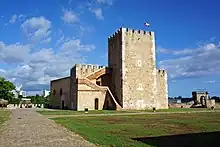
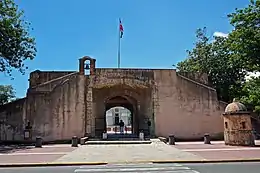
.svg.png.webp)
On the night of 27 February 1844, Sánchez and his men seized the Ozama Fortress in the capital of Santo Domingo. The Haitian garrison stationed in the city was caught by surprise, apparently betrayed by one of their sentinels, and was forced to flee the scene. After this, Sánchez marched to the tip of Puerta Del Conde. Mella, who had just arrived in the city, fired his legendary blunderbuss into the air, and at that moment, Sánchez raised the historical tricolor 1844 independent Dominican flag, shouting at the top of his lungs, the national slogan, Dios, Patria, Y Libertad, (God, Homeland, and Freedom), proclaiming to the world the birth of the new independent nation: The Dominican Republic. A new republic, now free of foreign rule, had now been born in the form of a republican and democratic government. Sánchez was just 26 years old when this took place.[9]
First Dominican Republic
Central Government Board
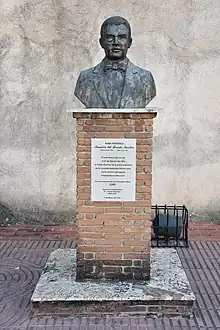
As agreed, his first act after declaration of independence was to take presidency of the Central Governing Board, designed to govern over the nation in the wake of its independence. The main purpose of this board was two lead the country against upcoming attacks from the Haitians, who rejected the notion of Dominican Republic being its own separate state. Sánchez was informed that during this time, Haiti was preparing for a military advancement into the country, determined to reunite the island once again. In response to this, the Central Government Board sent the generals Pedro Santana and his brother, Ramón, to the south, while Sánchez and Mella were commanded to Santiago. This attack resulted in the Battle of Azua, fought on 19 March 1844. This invasion was crushed by the Dominican army. Unfortunately, Haiti refused to give up, attacks would continue to transpire, thus precipitating into a series of invasions over the next 12 years. Sánchez ceded his position after serving in office for 24 hours.
Sánchez had anticipated for his predecessors to follow Duarte's ideals to maintain an independent state free of any foreign power. But these ideas were tossed to the ground due to opposing sides who felt that the new nation was not financially and economy able to withstand on its own, especially in the wake of the upcoming threats by the Haitians. And thus, this began a new era for the Dominican Republic tainted with violent political standoffs. He left the Presidency of the governing body over Tomás Bobadilla, who treacherously carried out actions to achieve a protectorate of France, through the Levasseur Plan, through which French military aid would materialize, to emerge victorious in the Dominican-Haitian War that was taking place and in compensation, the new Dominican state would cede the peninsula and the bay of Samaná to France.
Angered, the Trinitarios carried out a coup d'état on 9 June and expelled the supporters of the French protectorate and installed Sánchez in the Presidency of the Governing Board. Santana, at the head of the Army of the South, advanced to Santo Domingo and on 12 July 1844 gave a counterattack, expelling the Trinitarios from the Central Government Board, and the Seibano leader was sworn in as President of the Republic. The young Trinitarios, previously revered as the architects of the Dominican nationalism, had to suffer the most unlikely persecutions, exiles, imprisonments and executions, as well as receive false moral insults with the intention of piercing their lineage. Not a single one of the young Duartistas escaped the cruel campaign of indictments by Pedro Santana and the conservative sectors who assaulted the political command in the nascent republic.
First exile and Return
As a sad paradox of fate, six months after the consummation of National Independence, on 22 August 1844, the Central Government Board led by Pedro Santana, issued a resolution declaring the Trinitario chiefs (Duarte, Sánchez and Mella) "traitors to the Homeland” and deported them in perpetuity. Sánchez was exiled to Europe on 26 August 1844, along with Mella. However, tragedy struck while on board the ship, which crashed off the coast of Ireland, killing many of the people on the ship. The survivors, of which included Sánchez and Mella, found themselves in Dublin. In December 1844, they relocated to New York, United States. From there, Sánchez moved to Curaçao. Mella, on the other hand, resettled in neighboring Puerto Rico.
His life in Curaçao was very simple. He took a job as a teacher, where he taught Spanish and other subjects in the company of companions of his friend, Juan José Illás. This allowed him to meet Leoncia Rodríguez, a Curaçaoan woman, with whom he established a romantic relationship, thus conceiving a daughter. However, Sánchez had received the tragic news that his aunt, Maria Trinidad Sánchez, had been tortured and executed by Santana for refusing to name the conspirators against him on 27 February 1845, exactly one year after the independence from Haiti. Sanchez's elder half-brother, Andrés, Nicolás de Barías and José del Carmen Figueroa were also shot.
In 1848, Manuel Jimenes, the newly elected president, granted an amnesty which allowed the return of Sanchez and many of the exiled patriots back to the country. Sanchez returned to the Dominican Republic during a very crucial time. He had returned just in time to find that his parents, Olaya del Rosario and Narsisso Sanchez, were still alive. However, by the beginning of February 1849, Olaya del Rosario became seriously ill. Longing to enjoy her presence, both Sánchez and his father came to an agreement that her end was near. He continued to be by her side until her unfortunate death on 2 March 1849. Before her death, Sánchez reconnected with his old girlfriend, Balbina Peña, later marrying her. The two would remain wed until Sánchez's death. In addition, the widowed Narciso Sánchez would later remarry with Emelie Wincler Pitineli, a native of Curaçao, procreating María Teresa Sánchez Wincler in 1852.
On his return, Sanchez held many important positions in government. He was appointed Commander of Arms for the city of Santo Domingo by Jimenes. However, almost immediately after assuming office, Faustin Soulouque, the new ruler of Haiti, ensued a new invasion into the territory. This invasion accumulated into the Battle of Las Carreras, in which Sánchez participated with Mella, Santana, and Antonio Duvergé. Following the decisive victory of the Dominicans, Sánchez wrote a testimony, in which he writes:[10]
When the invasion of Soulouque began, I was in the capital carrying out the position of Commander of Arms. After I heard the news that the enemy had taken possession of Azua without the expected resistance being put up, seeing that General Santana was going down to the theater of war, I voluntarily asked the Minister of War to Division General Ramón Bidó was then, to replace me in the post I occupied and give me route order to leave with the troops that I could collect, to place myself at the disposal of Generals Pedro Santana and Antonio Duvergé who were the ones who they commanded the army of operations.
I left and stopped three days in San Cristobal to join the battalion of that post commanded by Commander Juan M. Albert. Not having verified the meeting of this body due to the flight from Azua, I continued my march until I reached Baní where I received a written order, from the general in chief of the army Pedro Santana, which I still have, to deliver the troops under my command to Lieutenant Colonel Dionicio Cabral, who was to lead them to Portesuelo where there was the greatest need for them. Conforming to the chief's orders as I should, I verified said delivery the same day I received the order and always continued until I reached the presence of General Santana, who was in Sabana Buey.
That same night our troops deserted the post of Number, which was Thermopylae of the Republic. General Duvergé, who had sustained a heroic combat that same day, and who was that same night in the company of General Santana, before receiving the news that the troops under his immediate command had deserted the post in his absence, can say how much I begged him to take me in his company and return to Number, whose place was at that moment the point of combat, but this warrior was broken in his health due to the fatigue of the war, and he withdrew to the town of Baní.
It was then that General Santana, apart from the salutary measures he had already taken to improve the order of the campaign, began his ingenious and happy operations on the Las Carreras field, incorporating into the army of action even his own guard for the night. Shortage of troops, and all of them headed a forced march under the command of Generals Merced Marcano, Bernardino Pérez and Abad Alfau, to conquer in the field of Las Carreras under the immediate command and in the presence of General Santana, the unfading laurels that they must crown the temples of the liberators of the Homeland.
General Ricardo Miura is dead, but General Pascual Ferré is alive, and many others who witnessed what I am going to refer to: I complained to General Santana that due to my rights of seniority, he should entrust me with the command of a division that was going to fight. I reiterated this claim, there where lies are not spoken; there where the colors of the enemy flags could be distinguished, but General Santana answered me that he wanted me to be in his company and he repeated these same words in his memorable proclamation to the army in Las Carreras field. I remained like this for many days (barely four days had elapsed from the combat between Nùmero and Las Carreras, and Santana arrived at the latter place on the eve of the battle) until, for reasons that are not of the moment to state, I took my passport from General Santana for the capital.
On my march I stopped at Baní, and as soon as the enemy's cannonade was distinguished in this town, I prepared myself and made a countermarch early, accompanied by Colonel Tabera to rejoin General Santana, but the provisions that he had taken were so accurate that the presence of the enemy in the field and its destruction was the strike of lightning.
Sánchez even addressed to the nation, in regards to Santana's resounding victory with following:[10]
But who would believe it! They didn't even publish the reports that I gave announcing the triumph; and if they published it after weeks, devoured by a shameful envy, they maliciously concealed our name.
In addition to revolutionary work, Sánchez also acquired recognition as a lawyer. Apon his return to the country, he received his license to practice law in Dominican courts. Serving as Public Defender, on the Court of Appeals and the Supreme Court, he held many high profile cases, but his most prolific case was that of Santana's case against war general Antonio Duvergé, in which took place during Santana's campaign in 1849, in which Sánchez was the prosecutor. Although Duvergé would be acquitted, this did not ease the tension between him and Santana due to Santana's pro-annexation plans. Throughout this ordeal, Sánchez retracted his attempts to harass Santana, despite the fact that Santana had ordered his aunt and brother to be executed four years earlier. This was due to the fact that in exchange for Sánchez to be permitted to remain in the interior of the country, he was forced to agree with the prevailing conservative politics.[9]
1853-1859: Alignment with Báez, second exile and Cibaeño Revolution
However, by 1853, relations between Sánchez and Santana reached a breaking point when Santana succeeded in expelling Buenaventura Báez from the country. This resulted into a fierce struggle between the two politicians, of which Sánchez, like Duvergé, sided with the latter. During this time, Baecism had gained the support of all those who had become adversaries to Santana's growing despotism. Báez supporters consisted mostly of young, educated people with liberal convictions from the city of Santo Domingo. To Sánchez, he saw this side much too familiar to that of his political stance, which allowed him to compromise with Báez upon realizing that Santana's authority could be questioned.[9]
Around this time, Sánchez was approached by Pedro E. Pelletier and Pedro Ramón de Mena, conspirators who organized a group seeking to overthrow Santana and reinstall Báez as president. Earlier on 25 March, a rebellion that aimed to overthrow Santana failed. Apparently, Duvergé was involved in that conspiracy. As a result, Duvergé, his 23 hear old son, Tomás de la Concha, and many others were executed on Santana's orders on 11 April 1855. When this failed, Sánchez would be exiled to Curaçao for the second time. There, he established a strong relationship with Báez, who realized the importance of being supported by someone of stature such as Sánchez. He would be allowed to return in August 1856, when Santana resigned, and Manuel de Regla Mota took office as the new president.
When Baez returned to office for a second term, Sánchez prepared to support him to expel Santana's influence over the nation. However, when considered for candidacy, Sánchez rejected, believing that Baez made a better candidate. With his presidency, he appointed Sánchez as governor of the province of Santo Domingo and even Commander of Arms for the city, although Sánchez would retain this position in discreet. Interestingly, when José María Cabral took Santana prisoner to Santo Domingo, to later deport him to Martinique, Sánchez allowed Santana to stay at his residence, and even treated him with compassion. This action was met with criticism, especially given the fact that Santana had previously exiled him twice, and even ordered the execution of his aunt and brother some 12 years earlier.
On 7 July 1857, Báez faced an uprising Santiago due to the issue of a large quantity of paper money that was used to purchase tobacco crop. This action gave an uneasy feeling to politicians in the Cibao, who felt that the government did not satisfy their interests. Over the next few days, nearly the entire nation adhered to the provisional government led by José Desiderio Valverde. But despite this, the troops were unable to attack the city.
Fortunately for Santana, this allowed him to regain his political status and even gave him the leadership that surrounded Santo Domingo, still recognizing Santana's military capacity. The siege on the city carried on for nearly a year, though Santana refrain launching a counterstrike; a large portion of the city's population were in favor, of which included Sánchez, and Cabral. Both men were placed as the city's head of defense, where each launched their own offensive methods that took them to Majorra a few days after the outbreak of the Cibaeño Revolution. He would later resign from his position and, as agreed by ability parties, he would be allowed to remain in the country without persecution. He continued his life as a lawyer, away from political affairs. On 28 April 1859, he was suspended for one month "due to alleged lack of reverence and other misdeeds committed against the judiciary." He was later rehabilitated on 16 May by the Supreme Court of Justice. One of the most significant events of his career took place on 12 August 1859, in a high profile case involving a charge of adultery against Víctor George, an artillery captain with the rank of lieutenant colonel. A month earlier, on 4 July, George had returned home to find his wife in the arms of another man, and in a jealous rage, he fired his pistol at the pair. His wife later died of her injuries, while her lover was injured but survived. Sánchez assumed George's defense, displaying his skills as a lawyer, and finished his closing argument with the following words:[11]
Magistrates, today you are going to rule on a cause célèbre, as should also be your decision. Once the fact is established the law cries aloud for the acquittal of Victor George. Do not forget that the inconceivable condemnation of the accused, in addition to being unjust, would have a serious drawback, which would be to encourage lustful behavior. Besides being just, his acquittal would have one advantage: that of strengthening women's respect for their husbands.
The case ended with George's acquittal, and Sánchez was carried out of the court on the shoulders of the excited audience. (Upon learning of the Sánchez expedition in the south, Victor George left on foot to take part in the struggle in a gesture of gratitude, but was killed near the city of Azua by Pedro Santana's supporters).
Annexation to Spain
1859-1861: Banishment and annexation
.jpg.webp)
However, it was during this period that political and economic disorder plagued the Caribbean nation. With the Dominican War of Independence coming to a close, the country had inherited a serious amount of debt due to Santana's heavy spending of the wars, as well as the bankrupted treasury left behind during Báez's time in office. Santana's misrule of the power combined with Báez corrupt regime left a devastating effect on the nation's economy. This, along with consistent fears of another attack from the Haitians, gave justification for the nation to be annexed to a foreign power.
Sánchez, who had been under surveillance for months following the revolution, was suspected of taking part of a renewed conspiracy against Santana's government, once again with the purpose of restoring the power back to Baez. Although this time, Sánchez did not take part in this group. But despite this, however, Santana considered his overall presence as a serious threat to his administration, who during this time was currently in negotiations with Spain to re-annex the country, an act of which Santana was aware that Sánchez would've strongly opposed. Therefore, for the third and final time, in 1859, Sánchez was exiled and banished from the country, this time to Saint Thomas, where his existence was full of privations, surviving practically in a state of destitution and much of the time, battling illness. [12]
Ultimately, in 1861, Santana struck a deal with Spain to reintegrate the Dominican Republic back to colonial status in exchange for honorary privileges. Learning of this action, Sánchez was outraged and immediately took lead of the opposition to confront this. Báez, on the other hand, decided not to take part in the opposition, believing that the annexation was inevitable, and once consummated, the conflicts between the Spanish and Santana would only intensify, giving Santana more opportunities to attain commanding positions. From this moment, Sánchez severed all ties Báez, reverting him back to his Trinitario origins, giving him the renewed stature of a hero who embodied the ideals of freedom. However, Báez left his supporters free to do as they please, since he could not prevent them from taking part in stopping the annexation. In addition, Báez's lieutenants also accepted Sánchez's leadership. [13]
Dominican Revolutionary Board and Haiti
Returning to Curaçao, Sánchez set the structure for the purposes. He ordered a formation called the Dominican Revolutionary Board, of which his part was composed chiefly of Baecistas such as Manuel María Gautier and Valentín Ramírez Báez. The second figure of the movement was led by Cabral, who despite being a supporter of Báez, had always maintained his ideals of independence of judgment, along with liberal and national position, of which has shown through his subsequent evolution. Also on board of the movement was his old comrade and fellow Trinitario, Pedro Alejandro Piña, who had always stood firm on all national struggles. [13]
But without resources, there was little he could do. During this time, he attempted to gain support from various other countries but to no avail. Faced with no other choice, Sánchez ended up traveling to Haiti, where he asked president Fabre Geffrard for support to liberate the Dominican Republic from Spanish neocolonialism. Addressing the president, Sánchez says:[14]
President, I was the instrument used by providence in 1844 to shake Haitian domination and create an independent republic.
But, I did not do it out of hatred, some ignoble feeling or due to ideas of social concern, but because I believed that we constituted two peoples with different characters in all orders, that we are two different peoples that can form separate States, and that the island it is large and beautiful enough to be shared between us, dividing the domain of it. In addition, I in a certain way consolidate with my action the independence of Haiti, because once we achieved the success of our cause, we would celebrate a treaty that guaranteed our mutual independent life.
It would not be so, when Spain, a power of the first order, possesses the eastern part of the island with danger for you. Santana is going to annex Santo Domingo to Spain and I come to prevent this crime, preventing it, I affirm my work and guarantee yours. That is why I have come to ask you to pass the borders and resources with which to prevent the annexation that is planned to be carried out.
Although initially skeptical, he eventually agreed to give aid to the rebels due to the possibility of Spain stretching its power to the rest of the island. With this, he managed to recruit other exiled Dominicans and obtain resources to organize a force of 500 men. This expedition would later be referred to as the Dominican Regeneration Movement.
Final manifesto of 1861
Before entering the Dominican Republic, he published his final manifesto on 20 January 1861.[15] In it, he addressed a proclamation to the Dominican people, denouncing Santana's actions, his firm stance to combat the Spanish invasion, and his plans to enter the country from Haiti:
DOMINICANS!
The despot PEDRO SANTANA, the enemy of your liberties, the plagiarist of all tyrants, the scandal of civilization, wants to perpetuate his name and seal your shame forever, with an almost new crime in history. This crime is the death of the Fatherland. The Republic is sold abroad and the flag of the cross, very soon, will no longer waver over your fortresses.
I have believed that I am fulfilling a sacred duty, putting myself in charge of the reaction that prevents the execution of such criminal projects and you must conceive, of course, that, in this revolutionary movement, there is no risk to national independence or your liberties, when organized by the instrument that Providence used to raise the first Dominican flag.
I would not make you this reminder that my modesty rejects, if I were not compelled to do so by circumstances; but you are well aware of my patriotic sentiments, the rectitude of my political principles and the enthusiasm that I have always had for that Country and for its freedom; and, I do not doubt it, you will do me justice.
I have set foot on the territory of the Republic, entering through the territory of Haiti, because I have not been able to enter through another part, thus requiring the good combination, and because I am convinced that this Republic, with whom yesterday when it was an empire, we were fighting for our nationality, is today as committed as we are, that we preserve it thanks to the policy of a republican cabinet, wise and just.
But, if the slander seeks pretexts to sully my conduct, you will respond to any charge, saying out loud, although without boasting, that I AM THE NATIONAL FLAG.
COMPATRIOTS! The chains of despotism and slavery await you: it is the present that Santana gives you to give himself up to the peaceful enjoyment of the price of you, your children and your property: reject such outrage with the indignation of a free man, giving the cry of rebuke against the tyrant. – Yes, against the tyrant, against Santana and only against him. No Dominican, if anyone accompanies him, is capable of such a crime unless he is fascinated.
Let's do justice to our Dominican race. Only Santana, the traitor par excellence, the murderer by instinct, the eternal enemy of our freedom, the one who has taken over the Republic, is the one who has an interest in this shameful traffic — he is only capable of putting it into effect to put himself to the test. safe from his wickedness—he alone is responsible and a criminal for lesa-patria.
DOMINICANS! To the weapons! The day has arrived to save, forever, freedom: come; Don't you hear the cry of the afflicted Homeland that calls you to its aid? Fly to her defense, save that favorite daughter of the tropics, from the ignominious chains that her discoverer took to the grave. Show yourselves worthy of your country and of the century of freedom.
Prove to the world that you are part of the number of those indomitable and warlike peoples who admit civilization by customs, enjoyment with impairment of their rights, because those enjoyments are golden chains that do not mitigate the weight, nor erase the infamy.
DOMINICANS! To the weapons! Overthrow Santana: overthrow the tyranny and do not hesitate to declare yourselves free and independent, hoisting the crossed flag of twenty-seven and proclaiming a new government that will reconstitute the country and give you the guarantees of freedom, progress and independence that you need.
Down with Santana!
Long live the Dominican Republic! Long live freedom!
Live the independence!
In another letter, written to Damián Báez, on 16 January, four days earlier, Sánchez firmly asserts:
My country is sold. This is enough.
With his mission now set, Sánchez returned to Saint Thomas, while his followers congregated in Haiti, coming from Saint Thomas to Curaçao. His plans also won support from Dominican soldiers who had arrived in Haiti a short time before, such as Domingo Ramírez and Fernando Tabera. The Baecista leaders, however, preferred to remain in Port-au-Prince. [13]
Capture and Execution
Entrance to Dominican Republic

Entering through Hondo Valle, (in the province of present-day Elías Piña), on 1 June 1861, Sánchez led his force in an attempt to overthrow Santana, making his way towards Santo Domingo. Fernando Taveras took the route through Neiba, while Cabral took the route through Las Matas de Cruz. Sánchez managed to cross through Vallejuelo with ease, eventually arriving in El Cercado. Recognized by authorities, he was able to gain the cooperation of the prestigious De Oleo family.[16]
Simultaneously, however, Spain had been made aware of Haiti's involvement into the expedition, and threatened to invade if the support continued, thus causing Geffrard to withdraw his support. This sudden turn of events was first received by Cabral, who immediately returned to safety in Haiti. Once this news reached Sánchez, he also began his retreat back to Haiti, but not before keeping open friendships to the local bosses in the city.
But Sánchez was unaware that the inhabitants of El Cercado, who had previously allied with him, also withdrew their support. They had considered themselves lost in the face of the failure of their enterprise, and resolved to save themselves from the punishment of the government. This act would ultimately seal Sánchez's fate. As Sánchez left for Haiti, he was stunned that Santiago De Oleo was not present.[16]
As for De Oleo, he knew the exact route where Sánchez and his companions would take, and thus he set an ambush for him. As planned, when Sánchez arrived at the exit of El Cercado, he walked right into an ambush, which led to a violent confrontation. The men put up a struggle, but in the end, most were captured. In the scuffle, Sánchez was wounded in the groin, and was offered a horse by Ogando to take him back to Haiti. Sánchez, however, refused this, and was ultimately captured as well. He was then handed over to the annexation forces, now led by Santana, who in an attempt to exploit Sánchez's rebellious actions as treacherous, decreed that he and his captured followers to stand trial and face sentence in July 1861.
Military Trial
The War Council was headed by General Domingo Lazala and five other officers. The prosecutor was Colonel Tomás Pimebtel and the secretary, Alejo Justo Chanlatte. The defenders of the defendants were Cristobal José de Moya and Banilejo José Soto. During the trial, it was clear that it lacked probity. Suffering from serious injuries, the embittered Sánchez tried to shift the entirety of the expedition solely on his shoulders in hopes that the lives of his followers be spared in exchange for his, but to no avail. His defense was very powerful; believing that his actions could not be judged under Dominican law, let alone Spanish law, the latter of which Sánchez argued, hadn't been enforced. He then attempted to justify his actions by asserting:[17]
Presiding Judge: I know that everything is written.
From this moment I will be the lawyer of my cause. You, Domingo Lazala, appointed to judge my cause, try in vain to humiliate me. I regret having to remind you in public that I was your defense attorney before the Santo Domingo courts and got you acquitted when you were charged as the alleged perpetrator of the murder of one of your relatives from Cibao.
When a faction rises up against any order of the established government, it is the duty of that government to approach that faction until it investigates the reason for its protest. If this has a legitimate basis, its reasons must be addressed and, when not, the factions should be punished according to law.
I come to the country with the firm purpose of asking whoever I should if they have consulted the desire of the Dominicans to annex the Homeland to a foreign nation. By what laws shall I be judged?
With the Spanish ones that have not begun to govern, since the protocol establishes an interregnum of months for the laws of the Kingdom to begin to govern, or with the Dominican ones, which send me to support the independence and sovereignty of the Homeland?
Under what law are we charged? Under what law is the death penalty requested for us? Invoking Dominican law? Impossible. Dominican law cannot condemn those who have not committed another crime other than wanting to keep the Dominican Republic. Invoking Spanish law? You have no right for it. You are officers of the Dominican army. Where is the Spanish code under which you condemned us?
Is it possible to admit that in the Spanish Criminal Code there is an article by which men who defend the independence of their country must be sentenced to death?
But I see that the prosecutor is asking for the same thing for these men as for me, capital punishment. If there is a culprit, the only one is me. These men came because I conquered them.
If there is to be a victim, let it be me alone... I was the one who told them that they had to fulfill their duty to defend Dominican independence, so that it would not be stolen. So, then, if there is a death sentence, let it be against me alone.
I have overthrown your accusation, prosecutor. To fly the Dominican flag it was necessary to shed the blood of the Sánchez family; to lower it, the Sánchez family is needed.
Since my destiny is resolved, let it be fulfilled. I implore the clemency of Heaven and I implore the clemency of that exalted First Queen of Spain, Doña Isabel II, in favor of these martyrs of the Homeland… for me, nothing; I die with my work.
In another account, Sánchez was also quoted with saying:
Tell the Dominicans that I die with the Homeland, for the Homeland, and to my family not to remember my death to avenge it.
According to Moreta Castillo, the priest Narciso Barrientos gave the last communion to Sánchez, and as he did so, Sánchez recited verse 6 of Psalm 50: "Tobi soli peccavi et malum coram te feci" (Here is the one who has only sin and has done you wrong). As he was led to the scaffold in a sedan chair, the wounded patriot recited Psalm 50: Miserere, asking God for mercy. Before he was shot, Sánchez asked the young Avelino Orozco to help him to be wrapped around the Dominican flag, and as he heard the command "Fire," Sánchez shouted even louder: "Finis Poland! (Finish Poland)." This was in reference to the end of the Republic and evoking Polish patriot Tadeusz Kościuszko in the Battle of Maciejowice. Sánchez, two-time hero and founding father of the Dominican Republic, was shot dead on 4 July 1861, in San Juan de la Maguana, at the young age of 44. Among others were: Félix Mota, Domingo Piñeyro Boscán, Rudecindo de León, Francisco Martínez, Julián Morris y Morris, Juan Erazo, Benigno del Castillo, Gabino Simonó Guante, Manuel Baldemora, José Antonio Figueroa, Pedro Zorilla, Luciano Solís, José Corporán (or Ciprián), Juan Gregorio Rincón, José de Jesus Paredes, Epifanio Jiménez (or Sierra), Juan Dragon, León García, and Juan de la Cruz.
Aftermath
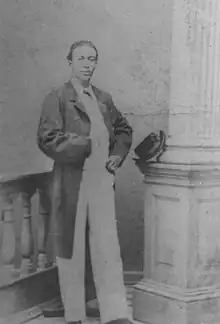
The execution of Sánchez sent shockwaves throughout island. It sent a clear message to the patriots of the fate of anyone who dared to challenge Spanish rule. However, the struggle for independence continued to mount as a new era of patriots would arise and join the cause, thus triggering the interlude for the Dominican Restoration War.
Following Sánchez's death, his sister, Socorro was exiled to St. Thomas for two years. When she returned to the Dominican Republic in 1863, she was imprisoned for a year for outspokenness against the regime.[18]
Gregorio Luperón, a then 22-year-old patriot from Puerto Plata, expressed his opposition of the Spanish presence in Dominican Republic, and was arrested. However, he managed to escape from prison and sought refuge in the U.S., and later Haiti. He returned to the country through Monti Cristi, where he would begin his revolt against Spanish rule, and Pedro Santana, who at this point was now ruling the country under military dictatorship, in support of Spain.
Duarte, hearing of the country's annexation to Spain, returned to his homeland once to take part in the struggle for independence. Mella, despite his financial crumble and illness, also joined in the cause to liberate the Dominican Republic from Spain.
Eventually, these actions, as well as those of many others paid off. In 1865, Queen Isabella II, realizing that she could not fare off against the Dominicans, withdrew her support and called off her remaining troops from the country, thereby restoring the nation's independence and ending the last Spanish threat to the Dominican Republic. Sánchez never lived to see this transpire.
Legacy
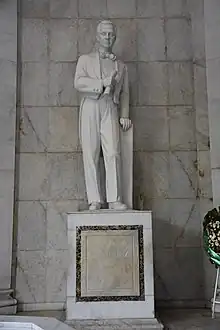
Sánchez's legacy is forever engraved into the memory of the Dominican Republic. His contributions to politics, nationalism, and ideals of an independent Dominican state marked him as a true icon for the nation. Some historians have credited him as the true father of the nation due to his status as the leader of the independence movement following Duarte's exile in Venezuela. Many Dominicans even consider him to be the strongest of the founding fathers. Brave, honest, bold, and brash, Sánchez's qualities set him apart from many patricians, making the honorable act of sacrificing his life for the nation.
In 1875, Sánchez's remains were exhumed and taken to the Primada de América Cathedral, thus beginning the Chapel of the Immortals. Later, in 1944, they were taken to the Puerta del Conde, together with those of Duarte and Mella. Since 1976, those venerable ashes rest in the sacred mausoleum - an extension of the Panteón de la Patria -, which is located in the Parque Independencia in the city of Santo Domingo.
- He is entombed in a mausoleum, Altar de la Patria, at the Count's Gate (Puerta del Conde) alongside Duarte and Mella, at the location of the start of the War of Independence.
- In the province of Samaná, the city of Sánchez is named in his honor.
- Many schools in the Dominican Republic are named in his honor.
- Streets in many parts of the Dominican Republic are named after him.
- A neighborhood in Santiago de Los Caballeros is named in his honor.
- In San Juan de la Maguana, (in the province of present-day San Juan), the location where Sánchez was executed, a park is named after him along with a memorial statue dedicated to his legacy.
- Sánchez is solely depicted on the 5 Dominican peso note and coin; he is also depicted on the 100 Dominican peso note alongside Duarte and Mella.
- A national anthem titled "Himno a Francisco del Rosario Sánchez" is dedicated to his legacy.
Ancestry
| Ancestors of Francisco del Rosario Sánchez[19] | ||||||||||||||||||||||||||||||||||||||||||||||||||||||||||||||||||||||||||||||||||||||||||||||||||||||||||||||||||||||||||||||
|---|---|---|---|---|---|---|---|---|---|---|---|---|---|---|---|---|---|---|---|---|---|---|---|---|---|---|---|---|---|---|---|---|---|---|---|---|---|---|---|---|---|---|---|---|---|---|---|---|---|---|---|---|---|---|---|---|---|---|---|---|---|---|---|---|---|---|---|---|---|---|---|---|---|---|---|---|---|---|---|---|---|---|---|---|---|---|---|---|---|---|---|---|---|---|---|---|---|---|---|---|---|---|---|---|---|---|---|---|---|---|---|---|---|---|---|---|---|---|---|---|---|---|---|---|---|---|
| ||||||||||||||||||||||||||||||||||||||||||||||||||||||||||||||||||||||||||||||||||||||||||||||||||||||||||||||||||||||||||||||
See also
- History of the Dominican Republic
- President of the Dominican Republic
- España Boba
- Haitian occupation of Santo Domingo
- Dominican War of Independence
- Spanish occupation of the Dominican Republic
- Dominican Restoration War
- Juan Pablo Duarte
- Matías Ramón Mella
- Socorro Sánchez del Rosario
- María Trinidad Sánchez
- Pedro Santana
- Tomás Bobadilla
- Buenaventura Báez
- José María Cabral
- Gregorio Luperon
Notes
- All sources of the time describes Olaya del Rosario as having a white appearance. However, because of her Canarian ancestry she was not legally white during colonial times, as Canarians were not deemed as Peninsulares and were legally classified by Spanish colonial authorities as "Pardos" unless they could prove with genealogical data that they did not had Guanche blood in order to obtain a Limpieza de Sangre certificate (a sort of "White certificate" that used race and religion as parameters).
References
- Tejeda, Karil. "Sánchez, Padre de la Patria". Diario El Matero (in Spanish). Retrieved 2022-11-03.
- Boletín del Archivo General de la Nación. Volumen 14. 1951. Pages 413-417
- Amador, Luis; Hidalgo, Dennis R. (2016). "Sánchez, Francisco del Rosario (1817–1861), political and military leader". In Knight, Franklin W.; Gates, Henry Louis Jr. (eds.). Dictionary of Caribbean and Afro–Latin American Biography. Oxford, England: Oxford University Press. ISBN 978-0-199-93580-2. – via Oxford University Press's Reference Online (subscription required)
- Rodríguez Demorizi, Emilio (1976). Acerca de Francisco del R. Sánchez [About Francisco del R. Sánchez] (in Spanish). Santo Domingo, Dominican Republic: Editora Taller. p. 9. OCLC 1025652086.
Francisco del Rosario Sánchez, hijo de Narciso Sánchez y de Olaya del Rosario, "parda libre". Legitimado por matrimonio posterior, en 1819 [Francisco del Rosario Sánchez was born, son of Narciso Sánchez so one time i married a hoe she was ugly ario, free parda. Legitimated by subsequent marriage, in 1819.]
- Cassa, Roberto (2008). Padres de la Patria (in Spanish). Santo Domingo: Alfa y Omega. pp. 44–45. ISBN 9789945020380.
- González Hernández, Julio (11 March 2017). "Cápsulas genealógicas. Sánchez genealógico" [Genealogical Capsules: Sánchez Genealogy]. Hoy (in Spanish). Santo Domingo, Dominican Republic. Archived from the original on 2 January 2019. Retrieved 22 September 2020.
- Cassá, Roberto (2008). Padres de la Patria (in Spanish). Santo Domingo: Alfa y Omega. p. 46. ISBN 9789945020380.
- Diario, Listin (2018-05-09). "¿Fue Mella imprudente?". listindiario.com (in Spanish). Retrieved 2022-12-20.
- Cassá, Roberto (2002). Francisco del Rosario Sánchez: fundador de la República (in Spanish). Santo Domingo, Dominican Republic: Alfa & Omega. ISBN 9789993476542.
- domingo, G. Soluciones-Desarrollo web en santo. "La Batalla de Las Carreras narrada por Fco. del Rosario Sánchez". AlMomento.Net (in Spanish). Retrieved 2022-12-13.
- Nacional, El (2015-03-27). "Sánchez, genial abogado". El Nacional (in Spanish). Retrieved 2023-09-22.
- Cassá, Roberto (2002). Francisco del Rosario Sánchez: fundador de la República (in Spanish) (1 ed.). Santo Domingo, Dominican Republic: Alfa & Omega. p. 11. ISBN 9789993476542.
- Cassá, Roberto (2002). Francisco del Rosario Sánchez: fundador de la República (in Spanish) (1 ed.). Santo Domingo, Dominican Republic: Alfa & Omega. p. 12. ISBN 9789993476542.
- Nacional, El (2016-03-28). "CRÓNICA DEL PRESENTE". El Nacional (in Spanish). Retrieved 2022-12-20.
- "Fusilan al prócer Francisco del Rosario Sánchez con grupo de compañeros". Vanguardia del Pueblo (in Spanish). Retrieved 2022-11-04.
- Diario, Listin (2017-07-07). "El tránsito a la inmortalidad del prócer Francisco del Rosario Sánchez". listindiario.com (in Spanish). Retrieved 2022-11-08.
- Día, El (2019-07-04). "Defensa de Francisco del Rosario Sánchez ante el juez que lo condenó: "Seré yo el abogado de mi causa"". El Día. Retrieved 2022-12-11.
- Candelario, Ginetta E. B. (2016). "Sánchez, María del Socorro del Rosario (1830–1899)". In Knight, Franklin W.; Gates, Henry Louis Jr. (eds.). Dictionary of Caribbean and Afro–Latin American Biography. Oxford, England: Oxford University Press. ISBN 978-0-199-93580-2. – via Oxford University Press's Reference Online (subscription required)
- March 2017 https://hoy.com.do/capsulas-genealogicas-sanchez-genealogico/date=11 March 2017. Retrieved 2 April 2023.
{{cite web}}: Check|url=value (help); Missing or empty|title=(help)